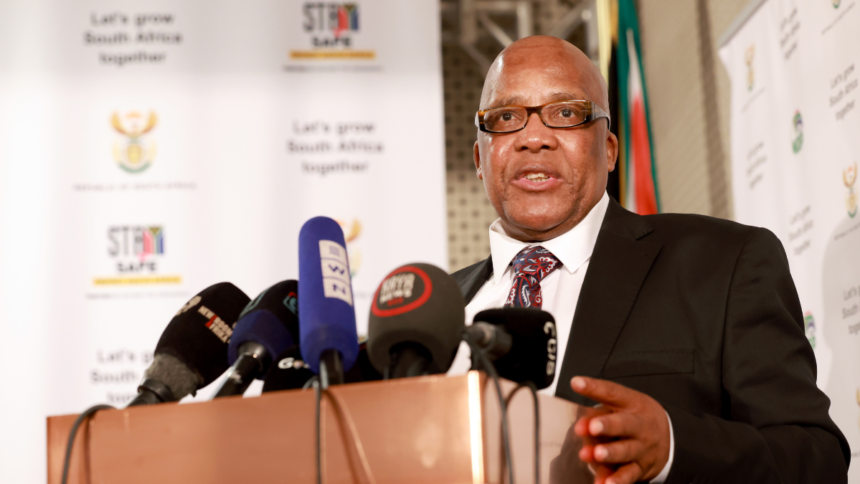The impact of the sudden withdrawal of funding from the US government for HIV and TB projects in South Africa has left a trail of abandoned mobile clinics and a looming crisis in the country’s healthcare system. The decision by US President Donald Trump to halt all Pepfar funding has had a devastating effect on organizations like the Anova Health Institute, which relied heavily on this support to provide crucial HIV services to communities.
The once bustling fleet of brightly painted trucks and trailers, emblazoned with Pepfar and USAid logos, now sit idle in a parking lot near Charlotte Maxeke Johannesburg Academic Hospital. The engines are dead, the tires flat, and rust has begun to spread across the vehicles. Plastic tape flutters in the wind between the abandoned vehicles, painting a stark picture of the fallout from the funding cut.
Health Minister Aaron Motsoaledi has been outspoken in his criticism of activists, researchers, and the media, accusing them of spreading misinformation and creating a crisis where none exists. Despite the loss of US funding, Motsoaledi remains confident in the country’s ability to weather the storm, citing the remaining 83% of the HIV budget that is funded through other sources.
However, activists warn of a looming catastrophe, with increasing numbers of people unable to access vital HIV treatment and prevention services due to the closure of NGO clinics. The collapse of these programs could undo years of progress in the fight against HIV and AIDS in South Africa.
Motsoaledi’s dismissal of the crisis has drawn criticism from figures like Fatima Hassan, who played a key role in securing free ARVs for people with HIV in the early 2000s. Hassan warns that the country is on the brink of another era of denialism, reminiscent of the dark days of HIV denial under former Health Minister Manto Tshabalala-Msimang.
As the debate rages on, the fate of South Africa’s HIV program hangs in the balance. Without a concrete plan to replace the lost US funding, the country faces an uncertain future in its fight against one of the deadliest pandemics of our time.
“No amount of finger-pointing will save lives — only urgency, evidence, partnership, proper planning, and resources will,” says Rees.
The consequences of the recent funding cuts from the US government have been devastating for HIV prevention and treatment programs in South Africa. The closure of Anova Health Institute’s mobile clinics, which provided essential HIV testing and treatment services to vulnerable populations, has resulted in a significant decrease in the number of people accessing ART in Johannesburg. This setback has the potential to lead to a surge in new HIV infections and AIDS-related deaths in the country.
Furthermore, the transfer of patients from specialized clinics to government facilities has not been seamless, with reports of discrimination and refusal of services by healthcare workers. Despite efforts to train healthcare staff to be more inclusive and welcoming to key populations, such as sex workers and transgender individuals, discrimination and stigma persist.
The impact of the funding cuts on South Africa’s HIV program is dire. Without adequate resources, the country faces the prospect of a significant increase in new HIV infections and AIDS-related deaths. Urgent action is needed to secure the necessary funds to sustain and expand HIV prevention and treatment services.
While the health minister has reported progress in getting people with HIV back on treatment, the reality is more complex. The failure to account for individuals who have stopped treatment or died means that the reported numbers are misleading. The stagnation in the number of people on ART highlights the challenges faced in maintaining and expanding HIV treatment programs.
It is crucial for all stakeholders, including the government, civil society organizations, and international partners, to come together to address the funding gap and ensure the continuation of life-saving HIV services. Only through a concerted effort to prioritize evidence-based interventions, partnership, proper planning, and the allocation of resources can we hope to make progress in the fight against HIV/AIDS in South Africa. No amount of finger-pointing will save lives — only urgent action and collaboration will.
As the HIV treatment program in South Africa continues to face challenges, concerns have been raised about the effectiveness of the current strategies in place. The recent announcement by the health department that 500,000 individuals have been put on treatment may not tell the whole story. It is possible that an equal number of individuals who were already on treatment may have stopped during this time, leading to a cycle of people going in and out of treatment.
The country’s goal of achieving the 95-95-95 targets, which aim to end AIDS as a public health threat by 2030, is also facing obstacles. Currently, South Africa is at 96-79-94, indicating a struggle to get people diagnosed with HIV onto treatment and to prevent those on treatment from defaulting on their medication. This highlights the need for improved strategies to ensure that individuals stay on treatment consistently.
One of the factors contributing to these challenges is the lack of leadership within the health department. The position of deputy director general for HIV and TB has been vacant for five years, leaving a gap in crucial decision-making roles. The absence of clear communication and transparency from the government has also been noted, with important information being difficult to access.
During the COVID-19 pandemic, the government utilized experts to provide regular updates and information to the public. However, the same level of engagement and collaboration with experts in the HIV field seems to be lacking. This has led to concerns among scientists and activists who feel that they are being sidelined in the decision-making process.
As the challenges in the HIV treatment program persist, individuals like the young transwoman in Hillbrow are left feeling anxious and uncertain about their access to treatment. With mobile clinics closing down and disruptions in the supply of ART pills, there is a growing sense of urgency to address the gaps in the current system.
Experts in the field emphasize the need for collaboration between the government and civil society to address these challenges effectively. By working together and leveraging the expertise of all stakeholders, it may be possible to develop more sustainable and comprehensive solutions to ensure that individuals receive the treatment they need to manage their HIV effectively.
As the debate continues on how best to address the gaps in the HIV treatment program, the importance of ensuring consistent access to treatment for all individuals affected by HIV remains a top priority. By addressing the root causes of treatment interruptions and implementing targeted interventions, it may be possible to improve the overall effectiveness of the HIV treatment program in South Africa.
At the Wits clinic, I received top-notch treatment without facing any ridicule, and I was also provided with self-testing kits for my sexual partners. But what stood out the most was the fact that I had access to free mental health services.
Contrastingly, when my friends visited the government Hillbrow clinic, they were unable to even obtain condoms, let alone receive proper treatment. This stark difference in the quality of healthcare services highlights the disparities that exist within our healthcare system.
The Wits clinic not only prioritizes physical health but also recognizes the importance of mental well-being. The fact that I could access mental health services for free was truly commendable. Mental health is often overlooked and stigmatized, but the clinic’s commitment to providing these services demonstrates a holistic approach to healthcare.
Additionally, the provision of self-testing kits for sexual partners is crucial in promoting safe sexual practices and preventing the spread of sexually transmitted infections. This proactive approach to sexual health is something that all healthcare facilities should strive to emulate.
It is imperative that all individuals have equal access to quality healthcare services, regardless of their socio-economic status. Disparities in healthcare can have detrimental effects on individuals’ overall well-being and can perpetuate existing inequalities in society.
As we navigate the complexities of our healthcare system, it is essential to advocate for equal access to comprehensive healthcare services for all. The Wits clinic serves as a shining example of what healthcare should strive to be – inclusive, compassionate, and accessible to all.







